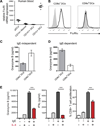IgE/FcεRI-Mediated Antigen Cross-Presentation by Dendritic Cells Enhances Anti-Tumor Immune Responses
- PMID: 25753415
- PMCID: PMC4559493
- DOI: 10.1016/j.celrep.2015.02.015
IgE/FcεRI-Mediated Antigen Cross-Presentation by Dendritic Cells Enhances Anti-Tumor Immune Responses
Abstract
Epidemiologic studies discovered an inverse association between immunoglobulin E (IgE)-mediated allergies and cancer, implying tumor-protective properties of IgE. However, the underlying immunologic mechanisms remain poorly understood. Antigen cross-presentation by dendritic cells (DCs) is of key importance for anti-tumor immunity because it induces the generation of cytotoxic CD8+ T lymphocytes (CTLs) with specificity for tumor antigens. We demonstrate that DCs use IgE and FcεRI, the high-affinity IgE receptor, for cross-presentation and priming of CTLs in response to free soluble antigen at low doses. Importantly, IgE/FcεRI-mediated cross-presentation is a distinct receptor-mediated pathway because it does not require MyD88 signals or IL-12 induction in DCs. Using passive immunization with tumor antigen-specific IgE and DC-based vaccination experiments, we demonstrate that IgE-mediated cross-presentation significantly improves anti-tumor immunity and induces memory responses in vivo. Our findings suggest a cellular mechanism for the tumor-protective features of IgE and expand the known physiological functions of this immunoglobulin.
Copyright © 2015 The Authors. Published by Elsevier Inc. All rights reserved.
Conflict of interest statement
Figures




References
-
- Bachem A, Guttler S, Hartung E, Ebstein F, Schaefer M, Tannert A, Salama A, Movassaghi K, Opitz C, Mages HW, et al. Superior antigen cross-presentation and XCR1 expression define human CD11c+CD141+ cells as homologues of mouse CD8+ dendritic cells. The Journal of experimental medicine. 2010;207:1273–1281. - PMC - PubMed
-
- Baker K, Qiao SW, Kuo TT, Aveson VG, Platzer B, Andersen JT, Sandlie I, Chen Z, de Haar C, Lencer WI, et al. Neonatal Fc receptor for IgG (FcRn) regulates cross-presentation of IgG immune complexes by CD8-CD11b+ dendritic cells. Proceedings of the National Academy of Sciences of the United States of America. 2011;108:9927–9932. - PMC - PubMed
-
- Burgdorf S, Scholz C, Kautz A, Tampe R, Kurts C. Spatial and mechanistic separation of cross-presentation and endogenous antigen presentation. Nature immunology. 2008;9:558–566. - PubMed
-
- Chatterjee B, Smed-Sorensen A, Cohn L, Chalouni C, Vandlen R, Lee BC, Widger J, Keler T, Delamarre L, Mellman I. Internalization and endosomal degradation of receptor-bound antigens regulate the efficiency of cross presentation by human dendritic cells. Blood. 2012;120:2011–2020. - PubMed
Grants and funding
- R01 DK074500/DK/NIDDK NIH HHS/United States
- R21 CA182598/CA/NCI NIH HHS/United States
- P30 DK043351/DK/NIDDK NIH HHS/United States
- R01 DK053056/DK/NIDDK NIH HHS/United States
- T32 CA070083/CA/NCI NIH HHS/United States
- F32 DK081256/DK/NIDDK NIH HHS/United States
- P30 DK034854/DK/NIDDK NIH HHS/United States
- R01 AI075037/AI/NIAID NIH HHS/United States
- P01 AI045757/AI/NIAID NIH HHS/United States
- R56 AI075037/AI/NIAID NIH HHS/United States
- R56 DK053056/DK/NIDDK NIH HHS/United States
- K01 DK093597/DK/NIDDK NIH HHS/United States
LinkOut - more resources
Full Text Sources
Other Literature Sources
Molecular Biology Databases
Research Materials

